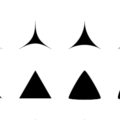 (Components :: Vrioon) Vrioon was originally released back in 2003 to great critical acclaim, the product of an unusual creative partnership between the hugely prolific Ryuichi Sakamoto and Carston Nicolai, aka Alva Noto. The two met in Japan during Nicolai’s first live tour, but it wasn’t until Sakamoto heard a Noto remix of his own work commissioned by Code Unfinished magazine a year later that this two-year project began.
(Components :: Vrioon) Vrioon was originally released back in 2003 to great critical acclaim, the product of an unusual creative partnership between the hugely prolific Ryuichi Sakamoto and Carston Nicolai, aka Alva Noto. The two met in Japan during Nicolai’s first live tour, but it wasn’t until Sakamoto heard a Noto remix of his own work commissioned by Code Unfinished magazine a year later that this two-year project began.
Vrioon was the product of musical creation via exchange rather than collaboration in the traditional sense, each artist composing, constructing and recording their parts of the process separately. Sakamoto built long passages of sparse yet emotionally charged and passionate piano solos, and Nicolai subsequently molded his trademark brand of sine waves, glitchy percussion and throbbing bass pulses around them.
The result of this ‘phoning-in’ process is a suite of amazingly cohesive and intertwined pieces that are contemplative, minimal and hypnotic. The aural equivalent of a solitary, spell in a Japanese stone garden, Nicolai’s systems-based rhythm structures sonically map the environment into which they are piped, while Sakamoto’s sensitive piano motifs breathe warmth and emotion into the mapped space. The protracted nature of these pieces further contributes to the music’s meditative aura and several pieces consist of two movements, the second eschewing the percussive elements of the first in favor of even more dreamy ambient layers.
Sakamoto has always been able to elicit a wealth of detail from even the most minimal of sources, and the elegant, minimal phrasing heard on the melancholy “Trioon I & II” is a perfect example. When coupled with medical bleeps, cool drones and half-felt bass glitches, the experience becomes positively transcendental.
Hard to sit down and listen to in one sitting as Vrioon can sometimes be, there’s no denying the understated impact that this body of work has, as well as the transforming and transporting effects it exerts both on the environment and the listener. If you only ever buy one release on the Raster-Noton label, this should be it.
::..:::…..:..::….:::::..:::..:::::::……:::…::.:::….::::..:..:::…::…….:::::
 (Collaboration :: Insen) Insen was the 2005 follow up to Vrioon, and the product of a much more conventional collaborative process that arguably yields less effective and affecting results. The poised precision and hypnotic repetition of the works on Vrioon are substituted here for more romantic, free form piano melodies and a greater range of layered sounds courtesy of Nicolai, the experience clearly intended to be discrete from that offered by Vrioon. The separation of piano and electronics is notably smaller here, often robbing the music of the beguiling simplicity that formed the core of Vrioon‘s success.
(Collaboration :: Insen) Insen was the 2005 follow up to Vrioon, and the product of a much more conventional collaborative process that arguably yields less effective and affecting results. The poised precision and hypnotic repetition of the works on Vrioon are substituted here for more romantic, free form piano melodies and a greater range of layered sounds courtesy of Nicolai, the experience clearly intended to be discrete from that offered by Vrioon. The separation of piano and electronics is notably smaller here, often robbing the music of the beguiling simplicity that formed the core of Vrioon‘s success.
Insen is also far more recognizably the work of Sakamoto despite the fact that his delicate piano phrasing is subjected to greater post-processing by Noto. Vrioon was the innovator and is arguably superior to its successor, Insen featuring a little too many by the numbers and oft-used techniques to be truly engaging. If you are familiar with much of Sakamoto’s other work then the repeated CD-glitch effects that are the focus of pieces like “Logic Moon” will be all too recognizable, offering little that is revolutionary or, for that matter, particularly engaging. It has all been done better on tracks like “Ngo/bitmix” (available on Sakamoto’s own Chasm album), although the following piece, “Moon” wisely combines the glitches with a more memorable melodic hook.
Some of the pieces are packed with interest: the experiment with volume in “Aurora” has the bass parts vary in their intensity, reaching out for the listener at unexpected moments, while Insen‘s most memorable and instantly recognizable moment – “Berlin,” the only piece to be recorded outside of the sessions in “Villa Aurora” – provides further evidence that the use of such a minimal sonic palette can be significantly altered by any number of external influences and is the only track to apparently feature field recordings, evidenced by the faint sound of birdsong. “Morning,” on the other hand, is cold, repetitive, verging on the atonal and almost unbearably tedious, “Iano” faceless and homogenous until its closing few minutes, and “Avaol” pads out the close of the album with three minutes of barely audible, directionless, interference-clad nothingness that has Sakamoto’s piano almost entirely consumed by Noto’s electronics.
Richer, warmer and more accessible than Vrioon, Insen takes its predecessors components and integrates them in a more involving and diverse manner, a technique that strangely dilutes the impact and success of the material rather than concentrates it. Insen inevitably presents itself as more of the same, though the subtle differences between this body of work and Vrioon do at least exude distinctly different moods. (Buy it at Amazon.com)
::..:::…..:..::….:::::..:::..:::::::……:::…::.:::….::::..:..:::…::…….:::::
 (Performance :: Insen Tour) 2005 saw Sakamoto and Nicolai taking the next logical step and performing their music on tour. Premiering at a single gig in numerous countries across the world, I was able to attend their performance at The Barbican Centre in London. The audience was suitably eclectic, a mix of Japanese guests, young couples and the odd celebrity or two (the Pet Shop Boys were conspicuous at the bar prior to the performance, for example), and this evoked suitably eclectic reactions: many serious faces could be glimpsed in the flickering light during the performance, whilst there were one or two expletive filled exclamations of confusion elicited from those who clearly did not share their friends or partners’ enthusiasm for the music during a particularly noisy drone experiment, followed by a swift departure to obtain more alcohol.
(Performance :: Insen Tour) 2005 saw Sakamoto and Nicolai taking the next logical step and performing their music on tour. Premiering at a single gig in numerous countries across the world, I was able to attend their performance at The Barbican Centre in London. The audience was suitably eclectic, a mix of Japanese guests, young couples and the odd celebrity or two (the Pet Shop Boys were conspicuous at the bar prior to the performance, for example), and this evoked suitably eclectic reactions: many serious faces could be glimpsed in the flickering light during the performance, whilst there were one or two expletive filled exclamations of confusion elicited from those who clearly did not share their friends or partners’ enthusiasm for the music during a particularly noisy drone experiment, followed by a swift departure to obtain more alcohol.
The stage set up was a simple one, cleverly designed to reflect the nature of the compositions themselves: the curves of Sakamoto’s piano and the mirror polished, angular workstation at which Nicolai stood were positioned to the far left and right of the stage atop a white geometric shape, whilst behind them stood a 30ft long (yet only several feet tall) plasma screen, a strip of visual activity that connected the artists throughout the performance, displaying harsh spots of light, expanding ripples in water or interactively scattered shapes. Soft colored lights reflecting the color schemes used on the covers of the Insen and Vrioon albums were used to great effect, heightening the mood of many pieces.
As expected, there was a considerable air of improvisation to the often quite considerably reworked pieces (taken both from Vrioon and Insen despite the ‘Insen Tour’ moniker) performed, and yet for those familiar with the studio recorded versions, the vast majority of these improvisations were surprisingly easy to detect. Sakamoto was clearly immersed in the process of extracting as much warmth, detail and emotion from the piano as possible as his romantic, virtuoso gestures clearly illustrated. Noto’s electronic accompaniments were correspondingly scaled up, the re-working of ‘Trioon I’, for example, building until a heavy-weight (by Sakamoto/Noto standards anyway) bass laden rhythm was pummeling the eardrums.
 There were also some rather less than successful experiments conducted during the performance. Sakamoto perhaps unwisely decided to confuse the audience from the outset with some atonal meddling with the very lowest registers inside the piano itself. For the uninitiated, this must have come across as both baffling and enormously pretentious. And of course there was the final piece – prior to the several encores – that can only be described as a dirge of white noise together with Sakamoto furiously pummeling the lower octaves of his keyboard as networks of white lines sparked across the plasma screen. Although undoubtedly a singular experience, this piece was prolonged for far too long: it had many audience members scratching their heads, covering their ears or looking at their watches and was treated to a far more hesitant, faint round of applause than others, at least until it became apparent that the concert was over. Unlike anything else the pair have either recorded or performed, its inclusion is a sheer mystery. Also working its way in was a cleverly segued version of Sakamoto’s ‘Merry Christmas Mr. Lawrence’ in the final encore, which raised a few smiles from the many otherwise serious faces.
There were also some rather less than successful experiments conducted during the performance. Sakamoto perhaps unwisely decided to confuse the audience from the outset with some atonal meddling with the very lowest registers inside the piano itself. For the uninitiated, this must have come across as both baffling and enormously pretentious. And of course there was the final piece – prior to the several encores – that can only be described as a dirge of white noise together with Sakamoto furiously pummeling the lower octaves of his keyboard as networks of white lines sparked across the plasma screen. Although undoubtedly a singular experience, this piece was prolonged for far too long: it had many audience members scratching their heads, covering their ears or looking at their watches and was treated to a far more hesitant, faint round of applause than others, at least until it became apparent that the concert was over. Unlike anything else the pair have either recorded or performed, its inclusion is a sheer mystery. Also working its way in was a cleverly segued version of Sakamoto’s ‘Merry Christmas Mr. Lawrence’ in the final encore, which raised a few smiles from the many otherwise serious faces.
The program that accompanied the evening made several key points about the performance, most notably that the intention of the pieces were to restore the much abused status of the piano as a pure instrument and that these performances are very much ‘in-development.’ The latter statement was borne out by the mixed results of the concert and the overheard comments of members of the audience afterwards, but the end result was a powerful performance from Sakamoto and a highly charged contribution from Noto that both added a new dimension to and provided a different take on the recorded works.
::..:::…..:..::….:::::..:::..:::::::……:::…::.:::….::::..:..:::…::…….:::::
Both releases are out now on Raster-Noton.
























